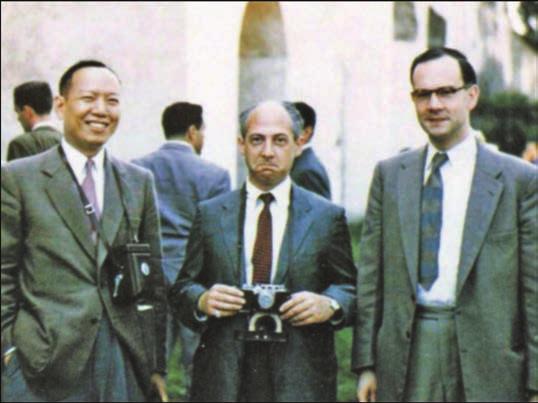by Graeme Segal
The month I spent in Bonn as a second-year graduate student in the autumn of 1964, when I first encountered Fritz Hirzebruch, remains one of my most vivid memories. When I think of all he must have been involved in I am humbled to think of his kindness in spending so much time, not just in talking to me about my work but in making sure that my wife, Desley, and I were at home and happy in what was for us a strange new world.
For a young Australian, Germany then was an overwhelmingly formal place. After two years I had just about become accustomed to the increased formality of England, but in Germany it attained another level. In retrospect I see that the country was poised on the brink of a great change in social style, and I think this was essential to Fritz’s magic. On one side he was the perfect German professor of the old school: although only thirty-eight, he had already served a term as dean of the Faculty of Sciences and was a figure of manifest authority. (My status rocketed with the very genteel elderly lady in whose house we were lodging when one day the Herr Professor arrived in person to pick me up.) He gave wonderful lectures, but what I most remember about them was his use of the German language — his long, elegant, articulated sentences in which every clause clicked faultlessly into place. Mathematicians had long since ceased to lecture like that in English; I wonder whether it still happens in Germany?

But there was another side, as Fritz had become part of the Princeton mathematical world with its very different manners. He had attracted Jacques Tits to Bonn as his closest colleague, and they called each other “Fritz” and “Jacques” in public, which was constantly remarked upon to me — sometimes with a definite hint of disapproval — by the Assistenten in the department. (Peter Pears and Julian Bream came and gave a recital in Bonn at the time, and the informality of their dress and demeanor on stage also caused a flutter.) I had no idea then of Fritz’s great achievement in rebuilding German mathematics from the late 1950s on, but it seems to me that a big part of his success must have come from his ability to shine in two, at least, very different styles at once, with always just the tiniest suggestion of ironical detachment from each. He evidently had a remarkable ability to see what was needed and what was possible for the mathematical world and a perfectly pragmatic way of pursuing it, with almost nothing showing of amour propre. Foreign mathematical visitors like me saw little of his “Germanic” style beyond the legendary clockwork perfection of the arrangements for the annual Arbeitstagung, but, looking back, I marvel at how, in gathering together such an outstanding panoply of diverse mathematicians from all over the world in his institute, he managed to seem — and indeed to be — so uniformly benevolent, sometimes in the face of much that was surely alien and even offensive to his own nature. I sometimes felt he had a special affinity with the Japanese visitors, whose reserved manners had something in common with his own.
I shall not try to talk about Fritz’s mathematical work, as I don’t feel the best-placed person to do that. I always admired his taste for beautiful concrete geometric examples and all he could extract from them, though I never myself worked quite in his area. But I cannot resist mentioning one of his earliest achievements. When I became a graduate student in 1962 the first suggestion made to me by my first supervisor, Sir William Hodge, was to try to read Hirzebruch’s Neue topologische Methoden in der algebraischen Geometrie, which had just appeared. It was far above my head then, but it begins with the piece of algebra whereby a formal power series gives rise to a multiplicative characteristic class for vector bundles. I was bewildered but tremendously intrigued by this, and I remember struggling with the proof that the only series \( f (x) \) such that the coefficient of \( x^m \) in \( f (x)^{m+1} \) is 1 for all \( m \) is the famous one \begin{equation*} f (x) = x/(1 - e^{-x} ) \end{equation*} which defines the Todd genus. I can only say that almost everything I have ever thought about in mathematics, in \( K \)-theory, index theory, elliptic cohomology, deformation quantization, or whatever has involved what I learned then.